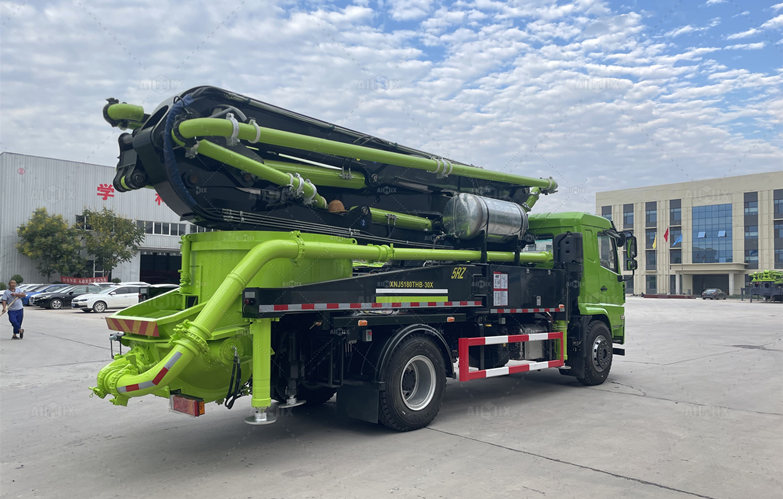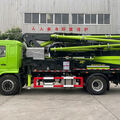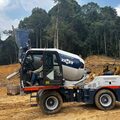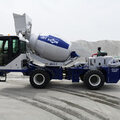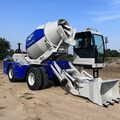Manufacturers implement rigorous quality control protocols before any portable concrete pump or concrete boom pump truck leaves the production facility, ensuring compliance with international safety standards and operational reliability. These comprehensive inspection processes verify every mechanical, hydraulic, and structural component meets exacting specifications through a combination of visual examinations, performance testing, and documentation review. For equipment combining the mobility of truck-mounted systems with the precise placement capabilities of boom pumps, these factory inspections become particularly critical given the dynamic stresses encountered during concrete pumping operations. The evaluation criteria cover everything from chassis integrity to computerized control system functionality, creating multiple checkpoints that collectively guarantee the portable concrete pump will perform safely and efficiently at job sites worldwide.
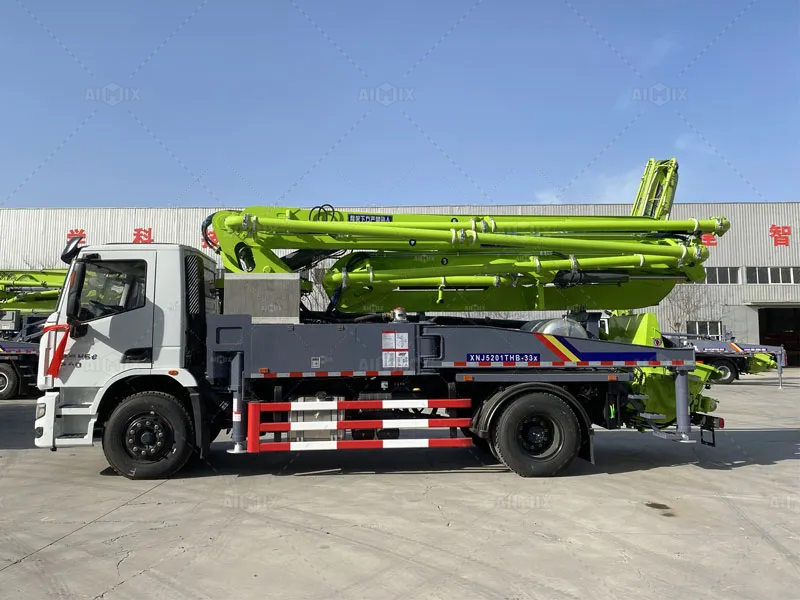
Structural Integrity and Welding Quality Assessments
The boom structure of a concrete boom pump truck undergoes meticulous inspection before leaving the factory, as these components endure tremendous dynamic loads during operation. Certified welding inspectors examine all critical joints using visual, ultrasonic, and magnetic particle testing methods to detect any subsurface flaws or imperfections that could compromise long-term durability. Dimensional accuracy checks verify that each boom segment maintains proper alignment within tolerances often as tight as ±1.5mm over 10 meters of length. Stress concentration areas—particularly where boom sections articulate and at mounting points to the truck chassis—receive additional scrutiny through strain gauge testing that simulates maximum operational loads. The portable concrete pump frame and outrigger systems similarly undergo non-destructive testing to confirm they can withstand the counterforces generated during pumping at full extension and capacity. Manufacturers document all structural inspections with photographic evidence and testing reports that become part of the permanent equipment record, allowing future service technicians to reference original conditions during maintenance or repair work.
Hydraulic System Performance Verification
The complex hydraulic systems powering both the pumping mechanism and boom movements on a concrete boom pump truck must pass exhaustive functional testing before factory release. Pressure testing confirms all hoses, valves, and cylinders can withstand 150% of rated operating pressure for sustained periods without leaks or deformations. Flow meters measure hydraulic fluid delivery rates to each actuator, ensuring proportional control response matches design specifications across the entire range of movement. Contamination control standards mandate fluid purity levels below ISO 17/15/12 cleanliness ratings, verified through periodic sampling during the testing process. The hydraulic power pack undergoes vibration analysis to detect any abnormal frequencies that might indicate impeller imbalance or misalignment in the pumping mechanisms. Special attention is given to the portable concrete pump hydraulic cooling system, with thermographic imaging used to verify adequate heat dissipation under maximum continuous load conditions that simulate tropical job site environments. All hydraulic components are tagged with traceability codes linking them to specific production batches for quality assurance purposes.
Electrical and Control System Validation
Modern concrete boom pump truck models incorporate sophisticated electronic control systems that require comprehensive validation before leaving the factory. The entire wiring harness undergoes continuity testing while exposed to vibration frequencies simulating road travel, ensuring connectors remain secure under real-world conditions. Programmable logic controllers (PLCs) are put through diagnostic routines that verify proper response to all sensor inputs and safety interlocks, including emergency stop functions and overload protection circuits. The human-machine interface (HMI) screens are tested for readability under various lighting conditions and evaluated for intuitive operation by test operators with varying experience levels. Wireless remote control systems—common on portable concrete pump models—are range-tested in electrically noisy environments to confirm reliable operation at advertised distances. Lightning protection systems are verified through simulated surge testing, particularly important for equipment destined for regions with frequent electrical storms. All software versions are documented and archived to facilitate future troubleshooting or updates in the field.
Pumping System Performance Testing
The concrete conveying system represents the core functionality of any concrete boom pump truck, demanding particularly stringent pre-delivery evaluation. Test pours using standardized concrete mixes verify that the pump can achieve rated output volumes (typically measured in cubic meters per hour) while maintaining consistent pressure levels throughout the boom's full range of motion. Wear parts like pistons, cylinders, and pipeline elbows are measured before and after test runs to establish baseline dimensions for future maintenance comparisons. The portable concrete pump material handling system—including hopper, agitator, and feed mechanisms—is evaluated for proper integration with the pumping cycle to prevent material segregation or blockage. Pressure relief valves are calibrated and sealed to prevent unauthorized adjustment, with test certificates documenting their exact activation thresholds. Special test protocols evaluate the system's ability to handle common job site contingencies like partial blockages or sudden shutdowns, verifying that safety responses perform as designed under fault conditions.
Chassis and Mobility Component Inspections
For truck-mounted concrete boom pump truck configurations, the carrier vehicle undergoes complete mechanical inspection following the same stringent standards applied to commercial truck manufacturers. Engine diagnostics confirm proper operation of all sensors and emissions control systems, particularly important given varying international fuel quality standards. The power take-off (PTO) system connecting the truck engine to the pumping mechanism is load-tested at maximum torque requirements while monitoring for vibration or alignment issues. Suspension components are evaluated under loaded conditions simulating the weight distribution during pumping operations, not just highway travel. The portable concrete pump outrigger system—critical for job site stability—undergoes extension and retraction cycle testing with load cells verifying equal force distribution across all support points. Steering geometry and brake performance tests account for the altered center of gravity created by the mounted boom and pumping equipment, ensuring safe road handling characteristics meet all applicable transportation regulations.
Safety System Certification and Documentation
No concrete boom pump truck leaves the factory without complete validation of all integrated safety systems. Boom movement limit switches are tested through full articulation cycles, with redundant sensors confirming position accuracy to prevent over-extension incidents. Load moment indicators (LMIs) are calibrated using certified test weights that simulate various concrete column weights throughout the boom's working envelope. Emergency shutdown systems are evaluated through simulated hydraulic line failures and electrical faults, verifying the equipment defaults to safe conditions. The portable concrete pump lighting and signaling systems—including obstacle lights and audible alarms—are checked for compliance with local regulations in target markets. All safety inspections are documented in multilingual manuals accompanying the equipment, along with detailed records of test parameters and results that can be referenced during periodic recertification inspections throughout the equipment's service life.
Final Quality Assurance and Preparation for Shipment
The last inspection phase before a concrete boom pump truck leaves the factory involves comprehensive quality assurance reviews and preparation for transportation. A complete walk-down inspection verifies that all fasteners are properly torqued, safety decals are correctly positioned in the appropriate languages, and no tools or test equipment remain in the machinery. The portable concrete pump undergoes thorough cleaning to remove manufacturing residues, with special attention to hydraulic reservoirs and other contamination-sensitive systems. Corrosion protection treatments are applied to exposed metal surfaces based on the climate conditions expected in the destination region. Shipping braces are installed to secure boom sections and other movable components during transit, with clear labeling indicating their proper removal during commissioning. Finally, the complete documentation package—including inspection records, parts manuals, and compliance certificates—is prepared for inclusion with the shipment, creating a comprehensive quality trail that supports future maintenance and validates warranty coverage.
Ongoing Quality Monitoring and Continuous Improvement
Leading manufacturers of concrete boom pump truck equipment don't consider factory inspections as merely final checkpoints, but rather as integral components of continuous quality improvement processes. Detailed inspection data is analyzed statistically to identify potential trends in component performance or manufacturing processes that could indicate emerging issues. Feedback from field service technicians about equipment performance under actual job site conditions is incorporated into updated inspection protocols for future production runs. The portable concrete pump testing procedures themselves undergo periodic review to ensure they remain aligned with evolving industry standards and technological advancements. This closed-loop quality management approach ensures that pre-delivery inspections continually adapt to address real-world operational challenges, maintaining the highest levels of safety and reliability that contractors depend on for their most demanding concrete placement projects.
